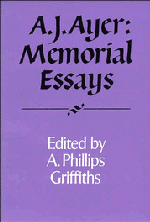Book contents
- Frontmatter
- Contents
- Preface
- A Defence of Empiricism
- Ayer: the Man, the Philosopher, the Teacher
- Ayer's Place in the History of Philosophy
- AYER'S ATTACK ON METAPHYSICS
- Ayer and World Views
- Language, Newspeak and Logic
- On the relation between Common Sense, Science and Metaphysics
- Logical Positivism and Intentionality
- Probability and the Evidence of our Senses
- Seeing Qualia and Positing the World
- Three Varieties of Knowledge
- The Importance of ‘If’
- Ayer's Ethical Theory: Emotivism or Subjectivism?
- Subjectivism and Toleration
- An Interview with A. J. Ayer
- Notes on Contributors
- References
- Index
Ayer's Ethical Theory: Emotivism or Subjectivism?
Published online by Cambridge University Press: 01 July 2010
- Frontmatter
- Contents
- Preface
- A Defence of Empiricism
- Ayer: the Man, the Philosopher, the Teacher
- Ayer's Place in the History of Philosophy
- AYER'S ATTACK ON METAPHYSICS
- Ayer and World Views
- Language, Newspeak and Logic
- On the relation between Common Sense, Science and Metaphysics
- Logical Positivism and Intentionality
- Probability and the Evidence of our Senses
- Seeing Qualia and Positing the World
- Three Varieties of Knowledge
- The Importance of ‘If’
- Ayer's Ethical Theory: Emotivism or Subjectivism?
- Subjectivism and Toleration
- An Interview with A. J. Ayer
- Notes on Contributors
- References
- Index
Summary
1. In 1936, in a chapter of Language, Truth and Logic clearly influenced by Hume (though inconsistent with Hume) and influenced also (Ayer later conjectured) by Ogden's and Richards's The Meaning of Meaning (1923), Ayer claimed that judgments of value, in so far as they are not scientific statements, are not in the literal sense significant but are simply expressions of emotion which can be neither true nor false. To say ‘You acted wrongly in stealing that money’ is not to state any more than one would have stated by merely saying ‘you stole that money’. To add that the action was wrong is not to make a further statement about it, but simply to evince one's moral disapproval. ‘It is as if I had said “you stole that money” in a peculiar tone of horror, or written it with the addition of some special exclamation mark. The tone or the exclamation mark adds nothing to the literal meaning of the sentence. It merely serves to show that the expression of it is attended by certain feelings of the speaker’ (LTL, 107).
Ayer adds that ethical terms like ‘wrong’ not only express feeling. ‘They are also calculated to arouse feeling and to stimulate action’ (LTL, 108). Some, for instance, like the term ‘duty’ as it occurs in ‘It is your duty to tell the truth’, may be regarded both as the expression of a certain sort of feeling about truthfulness and as the expression of a command, ‘Tell the truth’.
- Type
- Chapter
- Information
- A. J. Ayer: Memorial Essays , pp. 181 - 196Publisher: Cambridge University PressPrint publication year: 1992
- 1
- Cited by



